The reality of generative AI (GenAI) is catching up to the hype about how it could disrupt the roles of marketers and of marketing itself. Our April 2023 survey of over 200 CMOs from several sectors in eight countries in North America, Europe, and Asia revealed that CMOs around the world are optimistic and confident about GenAI’s future ability to enhance productivity and create competitive advantage.
This comes as no surprise, given the promotional publicity surrounding GenAI models and the rapid proliferation of large language models (LLMs) such as ChatGPT. No technology has ever reached 100 million users faster than ChatGPT, which crossed that threshold in just two months, far more quickly than Instagram, which needed two and a half years.
What is surprising is how deeply and extensively CMOs are exploring GenAI’s transformative power, benefits, and potential risks. Our survey revealed that CMOs are rapidly redefining the baselines for speed, efficiency, and quality in a wide range of marketing tasks. CMOs also see opportunities for GenAI to help their companies launch new products and implement new business models.
GenAI Has Already Affected Core Marketing Functions
Some 70% of survey respondents said that their organizations already use GenAI, while another 19% are testing it. (See Exhibit 1.) Applications include core marketing functions such as content generation, insight generation, and market segmentation. The greatest area of focus so far is personalization ; roughly two-thirds of respondents are pursuing efforts there.
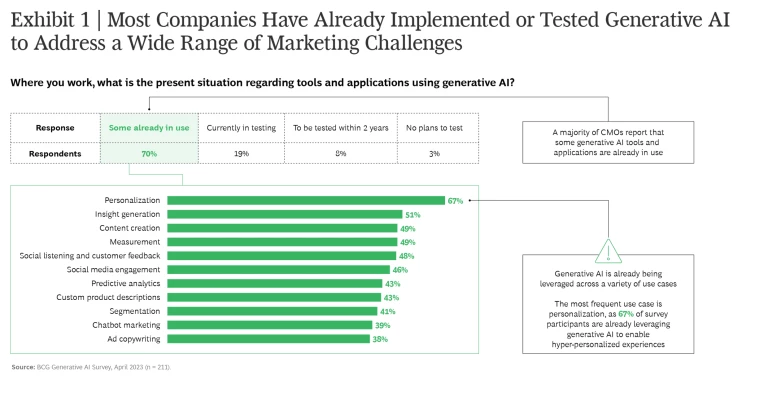
Three of the many areas the CMOs are exploring are personalization, content creation, and market segmentation:
- Personalization (67% of Respondents). Some banks are using GenAI to analyze customer data and offer personalized investment advice matched to their risk appetite. Some retailers are using GenAI to create hyper-personalized recommendations that entice shoppers to buy more. The goals and benefits of these efforts range from better engagement to improved conversion rates to increased customer loyalty.
- Content Creation (49%). GenAI helps marketing organizations create content faster, with higher quality and greater variety. Content creators can use these tools to create drafts, explore ideas, seek unusual combinations, and find other ways to inspire their teams’ creativity, rather than replacing or constraining it.
- Market Segmentation (41%). GenAI can enable CMOs to target customers more precisely. Better segmentation can improve resource allocation and ROI. GenAI can also enhance consumer and product strategy by changing how—and how fast—companies can conduct reliable market and consumer research and then use the resulting insights to improve their products and services.
One key finding from our survey is that GenAI works. Most CMOs see positive results right away, with 93% reporting a positive or very positive improvement in how they organize their work and 91% reporting a positive or very positive impact on their efficiency. Our own initial observations suggest that GenAI’s low cost and ease of use can yield productivity gains of as much as 30%.
Much of the discussion surrounding GenAI has involved these types of process improvements. The CMOs who participated in our survey expressed overwhelming confidence that GenAI can help their company handle a wide range of operational tasks faster, with less risk, and with greater efficiency. (See Exhibit 2.) It can also reduce the amount of time employees spend on tedious tasks, freeing up more time for value-added work. The onus is now on CMOs to capitalize on these additional levels of productivity and creativity to optimize their organization’s talent, headcount, and external relationships. These capabilities will also influence go-to-market strategies. The CMOs in our survey feel that GenAI will make it easier to launch new products and business models. Half of the CMOs see GenAI as a tool to accomplish both objectives simultaneously.
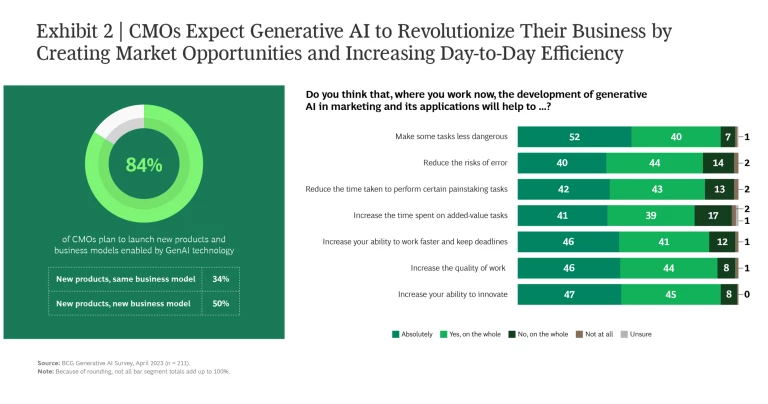
Inaction Is Not an Option
The speed at which companies derive benefits from GenAI tools can quickly create haves and have-nots in an industry. Companies that successfully implement GenAI will free up resources that they can use to acquire, serve, and retain customers more nimbly and effectively.
This means that inaction is not an option. Success requires coordination and foresight. We recommend that CMOs take four key actions. (See Exhibit 3.)
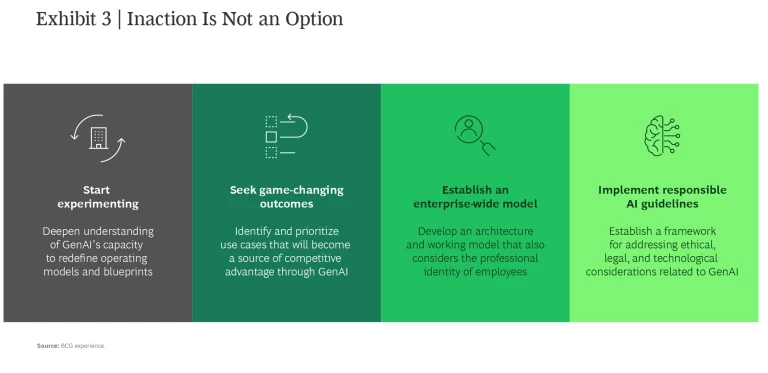
Start experimenting. To experience the potential of this technology first-hand, senior leaders must dive in and explore its capabilities. CMOs should encourage their teams to identify valuable applications, experiment with models, and start building transformative use cases. One approach is to create cross-functional agile marketing pods that can take on a task, such as launching a marketing campaign, with as much GenAI as possible. Once marketers find ways to hack their processes, the organization’s data scientists and engineers can automate and build connections to enhance it—for example, by using enterprise versions of LLMs or building application layers to produce output in more usable forms.
Seek game-changing outcomes. CMOs should aim to achieve step-change gains in productivity through innovative and disruptive approaches. Doing so creates a different risk-reward calculus for setting priorities. CMOs need to identify “golden” use cases that enable them to use their core data and IP assets uniquely to create a competitive edge. Training the models on IP and fine-tuning them with key data (marketing performance as well as consumer, brand, and market research) will also ensure that the outcomes are sufficiently differentiated from what competitors can produce. Settling for small gains with big ROIs may seem attractive, but a company can’t afford to walk when its competitors are running.
Establish an enterprise-wide model. Scale and competitive advantage are elusive in the absence of the right solution and architecture. Today’s GenAI model market is volatile, which exposes companies to two extremes: either selecting an unsuitable enterprise-wide provider or having to cobble together a collection of providers. Consumers and end-users have fueled unprecedented growth of LLMs, but now tech companies are developing suites of enterprise solutions to spur greater innovation. Developers can select different models that meet their needs from a library of LLMs, the goal being to find LLM providers that complement their existing cloud or tech supplier while retaining flexibility on the last-mile applications on top (providers of bots, content creation, and so on). These tools will enable CMOs and their teams to improve process efficiency, personalize customer interactions, inspire innovation through unconventional creativity, and create customer value in new ways.
Implement responsible AI guidelines. If an organization prohibits GenAI use or lacks centralized guardrails, one of two things is probably happening. Either employees are using GenAI anyway—professionally or privately—and recognizing opportunities for productivity improvements or the organization is falling behind competitors that are already pursuing and may be achieving double-digit-percentage gains in productivity.
The balance lies in incentivizing experimentation with GenAI while mitigating the numerous risks. Using AI responsibly means developing and operating AI systems that align with organizational values and widely accepted ethical standards while also achieving transformative business impact.
Most CMOs in our survey see AI regulations as inevitable, and the vast majority have undertaken some form of self-regulation. (See Exhibit 4.)
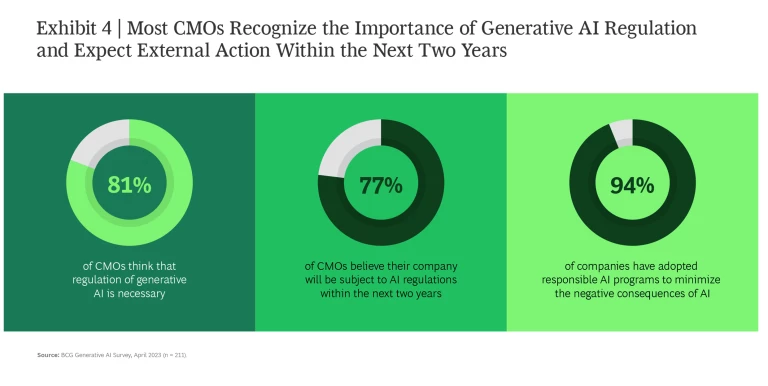
As is the case with any technology that has vast potential but no long-term track record, moving too quickly can create medium- and long-term risks related to unintended consequences—for example, when a particular choice of text and images clashes with desired brand tone and erodes brand strength. Among the numerous risks of unmanaged AI are proprietary data leaks, copyright infringement, biased output, sophisticated fraud, and even the risk of a shadow AI—a situation in which people throughout the organization regularly use external tools without proper guidance and supervision. Companies should layer branding plug-ins on top of their algorithms to ensure that the organizational styles that their marketers and agencies work with—such as tone of voice, color coding, authorized themes, and content—adhere to the brand’s approved framework.
Optimism and Confidence Far Outweigh Worry
CMOs in our survey were overwhelmingly optimistic and confident about the future impact of GenAI. When asked to select the words that best describe their feelings about GenAI, at least 70% of CMOs listed optimistic and confident among their top three. (See Exhibit 5.) More importantly, this optimism is pervasive. Every country and every sector showed similar results.
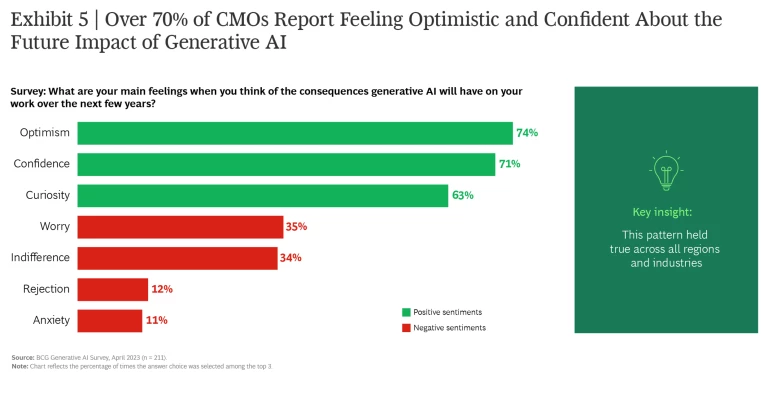
GenAI captures people’s imagination, because it is a breakthrough technology—the ability to converse with computers—that people have anticipated for decades. Whether GenAI is a disruptive innovation or a sustaining one depends on the organization and its ambitions. The disruptive potential of GenAI, however, seems to be foundational, in the same way that search engines and other online platforms upended business models and unleashed creativity three decades ago. It may have the power not only to revolutionize how companies perform certain marketing tasks, but also to redefine the role of marketing itself.
















